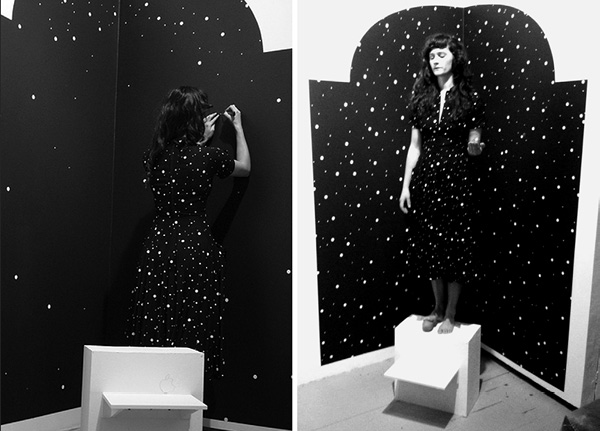
THERE IS SPACE FOR US
first performed on January 21, 2012
Boston Does Boston V, Proof Gallery, Boston, MA
performed once in 2012
MARIA MOLTENI
Boston, MA
979707612a979707612v979707612e979707612m979707612a979707612r979707612i979707612a979707612m979707612o979707612l979707612t979707612e979707612n979707612i979707612@979707612g979707612m979707612a979707612i979707612l979707612.979707612c979707612o979707612m
flickr.com/photos/mariamolteni/collections
THERE IS SPACE FOR US
MARIA MOLTENI
I enter an intimate gallery space and stop before a small installation comprised of a white pedestal and a suspended, 1940s-era vintage garment. A painted niche folded into one corner recalls the flattened forms and celestial domes of Byzantine iconography. The dress bears the same navy shade as the field it’s set against. A subtle rotating motion, induced by the building’s heating system, results in an ongoing perspectival distortion of white polka dots. I gently steady the dress, pull it from its hanger, and manage to slip into it, pulling the zipper along my spine. I climb on the pedestal, just above a small shelf that supports a found grey stone and hand-painted wooden egg. In the shadow of the egg, a trademark ”Apple” sticker has been pressed.
Turning into the painted corner, I begin to run my hands along the wall, picking at small round stickers that have been painted into the wall’s silhouette. For the next hour I continue to remove these hidden round stickers, revealing more and more of the constellations that reflect the pattern of my dress. I place most of the stickers into my dress pocket and must contort into various shapes to reach each piece from my perch. Upon removing the last stickers, my form has dissipated into the space behind, leaving only my arms, feet, and face clearly distinguishable. I turn back toward the audience and perform several simple rituals, rotating feet and fingers around the egg, stone and empty spaces that encase them.
This performance addresses the power of objects that linger beyond personal—primarily sexual—experience and how these experiences echo within a vast communal expanse. Interaction with a living altar comprised of archetypal and personally charged objects found, figured and gifted, makes reference to performative religious ritual. Their arrangement links moments within a larger narrative about romantic love and identity that has dissolved, but the content of this piece is not reliant on private history. In this piece, the woman (me) is simultaneously hypersexualized by traditional contexts, both religious and commercial, losing her “hourglass” form to the surrounding field in a durational piece that speaks to the transformation or rejection of the sexualized self. My movements refigure the composition of constellations. As they twist and buckle, the viewer may sense both the weight of one body’s presence in the universe as well as a potentially utopian collective vanishing point.